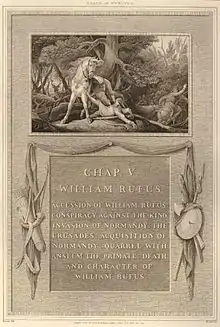James Neagle
James Neagle (1760?–1822) was a British engraver. Very largely a line engraver of book illustrations, he was prolific of designs by Thomas Stothard, Robert Smirke, Henry Fuseli, Gavin Hamilton, Henry Singleton, Richard Cook, and other popular artists.[1]
Life
Neagle went to the Royal Academy Schools in 1786. He had many commissions from the publishing firm of Cadell & Davies.[2] In 1801, in a civil action brought by Jean Marie Delattre the engraver against John Singleton Copley, over a plate, Neagle was a witness for the plaintiff. Towards the end of his life (after 1816) he emigrated to America, where he died not long afterwards in 1822.[1][2]
Works

Neagle's work included plates for:[1]
- John Boydell's and other editions of Shakespeare, including plates after Francis Wheatley;[2]
- John Sharpe's and Charles Cooke's series of English Classics;
- Edward Forster's Arabian Nights, 1802;
- Gil Blas, 1809, translated by Benjamin Heath Malkin;[2]
- Ancient Terra-Cottas in the British Museum, 1810, by Taylor Combe;[2] and
- James Cavanah Murphy's Arabian Antiquities of Spain, 1816.
A major work was The Royal Procession in St. Paul's on St. George's Day, 1789, from a drawing by Edward Dayes.[1]
Family
Neagle had a son, John B. Neagle (died 1866), who practised as an engraver in Philadelphia.[1]
Notes
- Lee, Sidney, ed. (1894). . Dictionary of National Biography. 40. London: Smith, Elder & Co.
- Painting, Vivienne W. "Neagle, James". Oxford Dictionary of National Biography (online ed.). Oxford University Press. doi:10.1093/ref:odnb/19816. (Subscription or UK public library membership required.)
| Wikimedia Commons has media related to James Neagle. |
- Attribution
![]() This article incorporates text from a publication now in the public domain: Lee, Sidney, ed. (1894). "Neagle, James". Dictionary of National Biography. 40. London: Smith, Elder & Co.
This article incorporates text from a publication now in the public domain: Lee, Sidney, ed. (1894). "Neagle, James". Dictionary of National Biography. 40. London: Smith, Elder & Co.